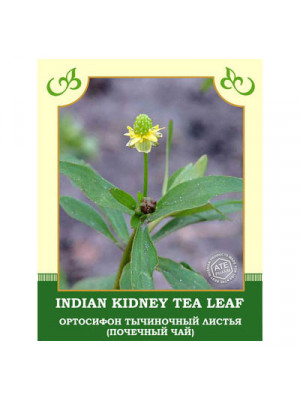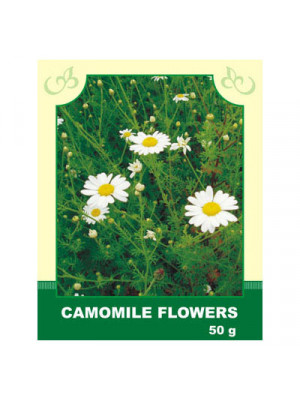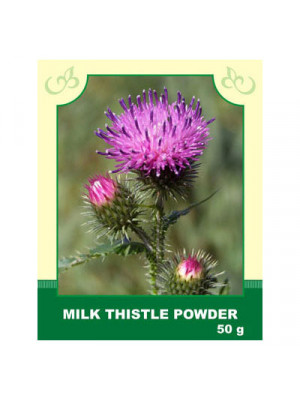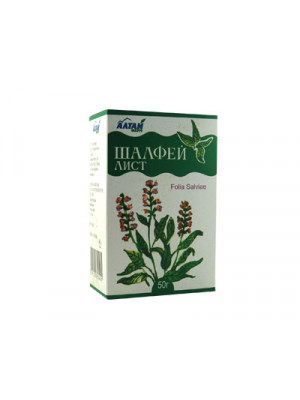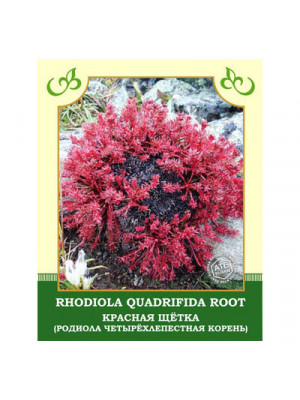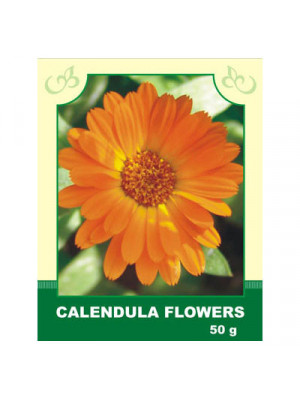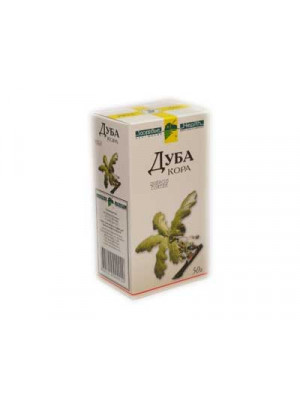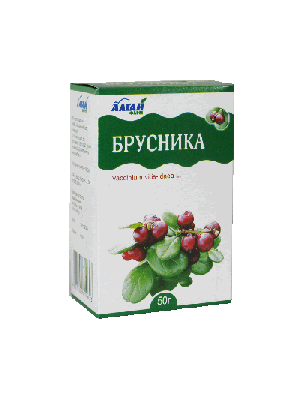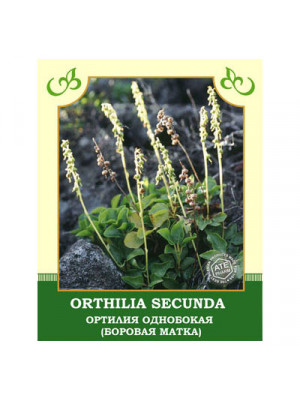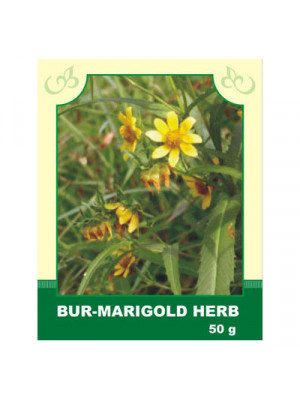Herbs
Internal use:
Consuming an infusion made from the herb of this plant is effective for cholelithiasis, edema of various origins, cystitis, kidney stones, rheumatism, gout, and diabetes. Better results are achieved when combined with other medicinal plants that have diuretic and anti-inflammatory properties (field horsetail, weeping birch, cranberry leaves, and knotweed).
Application and dosage: Pour 1/2 teaspoon of crushed herb with 200 ml of boiling water, heat in a water bath for 10 minutes, infuse for 45 minutes at room temperature, strain, bring the infusion to the original volume with boiling water, and drink warm 1/2 cup twice a day before meals for 4-6 months with monthly breaks of 5-6 days. In case of cholecystitis, take the infusion after meals.
Contraindications: Individual intolerance.
$7.99Internally: Taken for insomnia and migraines, gastrointestinal disorders, liver and bile duct diseases, meteorism, stomach spasms, diarrhea, menstrual disorders, and as a diaphoretic for colds.
Method of application and dosage: Steep 1 tablespoon of raw material in 200 ml of boiling water, infuse for 20-30 minutes, strain, squeezing the remaining raw material, take 2-3 tablespoons 3-4 times a day.
Externally: Used as an enema for colitis and hemorrhoids; as rinses for inflamed gums, mucous membranes, angina; as compresses for eczema, ulcers, boils; as a footbath for rheumatism, gout, arthritis, and bruises. For rinses and washes: steep 1 part of the herb in 20 parts of boiling water, infuse for 20-30 minutes, strain, and use as directed. For compresses and baths: steep 1 part of the herb in 10 parts of boiling water, boil for 15 minutes in a water bath, infuse at room temperature for 45 minutes, strain, squeezing the remaining raw material, and use as directed.
Contraindications: Individual intolerance. Do not wipe your eyes with chamomile infusion.
$6.99In folk belief, 1 tablespoon of meal is thought to completely neutralize alcohol before a feast. The leaves of milk thistle are considered a mild laxative and diaphoretic.
The seeds are used for hepatitis, gallstone disease, colitis, hemorrhoids, diseases of the spleen, thyroid gland, as well as for salt deposits, edema, dropsy, obesity, radiculitis, and joint pain in allergic skin diseases, baldness, and psoriasis. The meal is effective in alcoholism, constipation, reduces blood sugar levels, purifies the blood, and treats varicose veins.
Method of application and dosage: Steep 1 teaspoon of seeds in 250 ml boiling water, infuse for 20 minutes, strain, and drink hot in small sips, one glass in the morning on an empty stomach, half an hour before lunch, and in the evening before bedtime.
For the meal, boil 30 g in 0.5 L of water on very low heat until half of the liquid evaporates. Strain, drink 1 tablespoon every hour from morning to evening, or take 1 tablespoon of powder 4-5 times a day 20 minutes before meals, washed down with water. The course of treatment is one month. If necessary, repeat the course after 2-3 weeks. Halve the doses for children.
Contraindications: Individual intolerance.
$5.99Internal use: Taken for gastrointestinal spasms, inflammation of the gastric mucosa with reduced acidity of gastric juice, peptic ulcer of the stomach and duodenum, inflammation of the gallbladder and urinary bladder, as an expectorant for upper respiratory tract inflammation, to reduce milk formation in nursing mothers, for infertility, and to improve memory. Considered very effective during the menopausal period.
Application and dosage: Pour 1 tablespoon of raw material with 400 ml of boiling water and infuse for 20-30 minutes. Take 1/4 cup 3-4 times a day.
External use: Used for inhalations, rinses, and compresses to treat stomatitis, upper respiratory tract catarrhs, toothache, inflammatory skin conditions, purulent wounds, and for mild burns and frostbite. Use 2-3 tablespoons of finely chopped dry leaves per 500 ml of boiling water.
Contraindications: Individual intolerance, acute nephritis, pregnancy.
$6.99Internally, it is taken for weakened potency, infertility (both male and female), sexual coldness, ovarian and testicular cysts, impotence, mastopathy, polycystic ovary syndrome, and fatigue. It improves mental and physical performance, recommended for oncological diseases, enhances blood composition, increases resistance to infectious diseases, and promotes rapid bone fusion in fractures.
Method of application and dosage: 1 tablespoon of crushed root is poured with 250 ml of boiling water. Heated in a water bath with a closed lid for 15 minutes, stirring frequently. Infused for 45 minutes at room temperature, strained. Bring the decoction to the original volume with boiled water and drink 3-4 times a day 30-40 minutes before meals with 1 tablespoon of natural honey. The course of treatment is 30-45 days. Store the decoction in the refrigerator for no more than 2 days.
Contraindications: individual intolerance, pregnant and lactating women, patients with hypertension, fever, mental excitement. Cannot be used in combination with hops and licorice.
$8.99Internally, it is taken for gastritis, enterocolitis, stomach and duodenal ulcers; for inflammatory diseases of the liver and kidneys; in the treatment of heart diseases accompanied by palpitations, edema, and shortness of breath.
Method of application and dosage: 2 tablespoons of raw material are poured with 400 ml of boiling water, infused for 2 hours, strained, squeezing the plant material. The resulting infusion is brought to the original volume with boiled water. Take 1/2 cup 3 times a day.
Externally, in the form of rinses, douching, enemas, and compresses, it is used for diseases of the mucous membrane of the mouth and throat, gingivitis, thrush in children; for conjunctivitis; for abundant whites in women; for the treatment of wounds, burns, and ulcers on the body, in oncology. 20-40 g of raw material is poured with 200 ml of boiling water, heated in a boiling water bath for 15 minutes, infused at room temperature for 45 minutes.
Contraindications: individual intolerance, with low blood pressure.
$5.20Internally, decoction of oak bark is used as an astringent and anti-inflammatory remedy for stomach ulcers, gastric bleeding, blood in the urine, heavy menstrual bleeding, diarrhea, and frequent urges to urinate.
Method of application and dosage: 40 g of roots are poured with 200 ml of boiling water, infused for 30-45 minutes, strained, squeezing out the remaining plant material. The decoction of the herb with boiled water is brought to the original volume and taken in 1 tablespoon 2-3 times a day.
Externally, decoctions of the bark are used for rinsing in gingivitis, stomatitis, and other inflammatory processes in the oral cavity, pharynx, and larynx. Also, as compresses for burns, to stop bleeding from open wounds, and to reduce foot sweating. 20 g of bark is poured with 200 ml of boiling water, infused for 1 hour.
Contraindications: individual intolerance. Overdose may cause nausea and vomiting.
$5.79- Broth or water infusion of leaves used as a diuretic, choleretic and antiseptic treatment of inflammatory diseases of the kidneys and bladder, urolithiasis, gout, less as a binder for non-infectious diarrhea nature.$6.99
Description. Orthilia Secunda is native for Siberia. This herb consists of tannins, flavonoids, gums, bitters, lemon and tartaric acids, arbutin and saponin. Orthilia Secunda is recommended by herbalists as an herb for gynecological disorders and inflammations. Orthilia Secunda preparations are used for sterility, bleedings, infantilism, cervical erosion, for menstrual cycle derangements, toxicosis. In some countries Orthilia Secunda is used as diuretics and antiseptics for kidney and urinary bladder inflammations. More than that, the decoction of Orthilia Secunda is used as an eye wash.
Attention! Before using any herbal products, make sure that you have full knowledge of how the herb works and any adverse reaction it may cause.$8.99
Description.
Description. Bur-marigold is widely used in different ways. The herb is rich in tannins, bitters, volatile oil, vitamin C, carotin, iron, chrome, aluminum, copper and manganese. Bur- marigold can be taken internally and externally. The properties of the herb are numerous: sudorific, anti-inflammatory, diuretic, vitaminous, anti-allergic and sedative. Bur-marigold is of great help for metabolism disorders, digestion, gastrointestinal illnesses and skin inflammations. Use. Bur-marigold is used as preventive for influenza or cold, used for treatment of swelling pain at the throat, fever among infants, fear of cold weather. In some countries they use it for enteritis, flatulence, diarrhea, appendicitis, for sprains, contusions, chronic ulcers. The herb also helps stop wound bleeding and is good for piles, chronic ulcers, various skin diseases.
Attention! Before using any herbal products, make sure that you have full knowledge of how the herb works and any adverse reaction it may cause.$6.99


